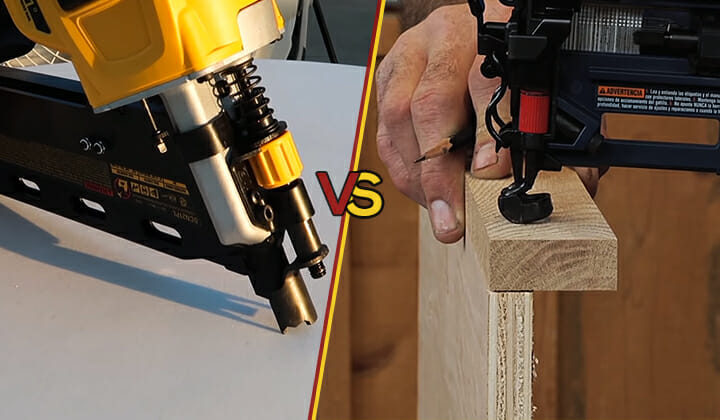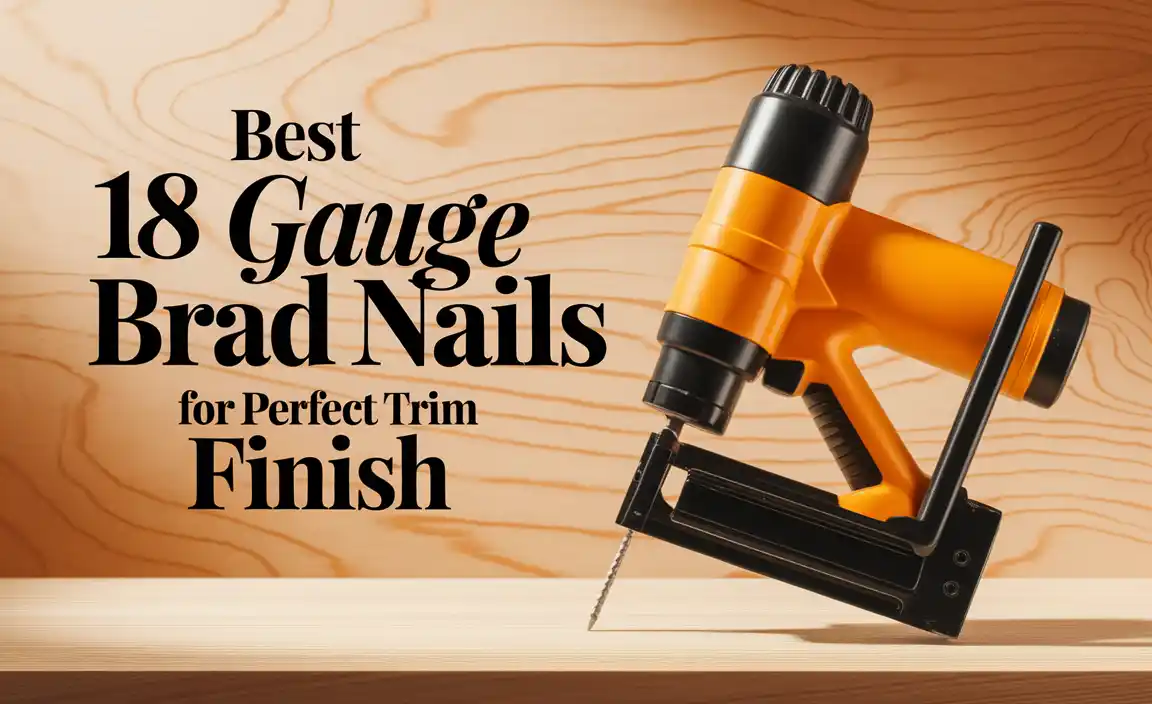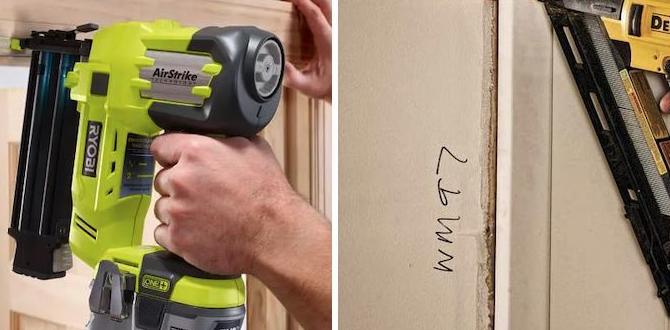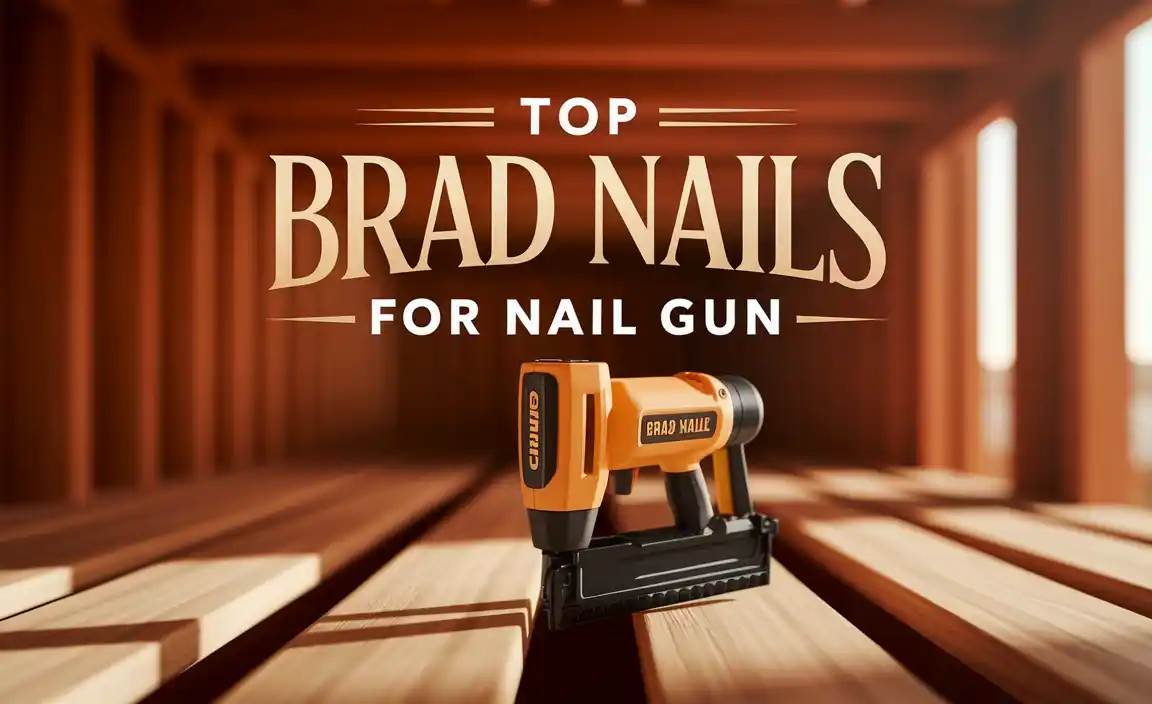When it comes to building projects, choosing the right tool is important. Have you ever wondered whether a finish nailer or a stapler is better for your tasks? These tools may seem similar, but they serve different purposes. One helps create strong, lasting connections, while the other offers quick and easy fastening.
For example, picture yourself working on a wooden frame for a treehouse. Would you want something sturdy, like a finish nailer? Or would a stapler be enough for lighter jobs, like attaching fabric for a cushion? Understanding the differences can help you make the best choice.
Interestingly, using a finish nailer can give your project a polished look. It hides nails beneath the surface. On the other hand, a stapler is perfect for quick fixes. It speeds up the process but may not provide the best finish.
Let’s dive into the fascinating world of finish nailers and staplers. Discover which tool suits your projects best and why! Your next DIY adventure awaits!
Table of Contents
Finish Nailer Vs Stapler: Which Tool Is Right For You? When It Comes To Woodworking And Home Improvement Projects, Choosing The Right Tools Can Significantly Impact The Quality And Efficiency Of Your Work. Two Common Tools Often Considered For Fastening Materials Are The Finish Nailer And The Stapler. This Article Aims To Explore The Differences, Advantages, And Applications Of Each Tool To Help You Make An Informed Decision. What Is A Finish Nailer? A Finish Nailer Is A Type Of Pneumatic Or Electric Tool Designed To Drive Finishing Nails Into Wood Or Other Materials. Finish Nails Are Typically Smaller Than Framing Nails, Making Them Ideal For Delicate Trim Work, Cabinetry, And Furniture Assembly. The Finish Nailer Provides A Less Noticeable Hole And Is Known For Its Ability To Create A Clean, Professional Finish Without Splitting The Wood. Advantages Of Using A Finish Nailer 1. **Precision**: Finish Nailers Allow For Precise Placement Of Nails, Enhancing The Overall Aesthetic Of The Project. 2. **Reduced Splitting**: The Smaller Size Of Finish Nails Minimizes The Risk Of Splitting The Wood. 3. **Speed**: Pneumatic Models Can Drive Nails Quickly, Significantly Reducing The Time Needed For Installation. What Is A Stapler? A Stapler, In The Context Of Construction And Woodworking, Refers To A Staple Gun. This Tool Drives Metal Staples Into Materials To Secure Them Together. Staple Guns Can Be Manual, Electric, Or Pneumatic And Vary In Size And Power Depending On Their Specific Use. They Are Commonly Used For Tasks Such As Attaching Fabric To Frames, Securing Insulation, And Fastening Thin Materials. Advantages Of Using A Stapler 1. **Versatility**: Staple Guns Can Be Used On Various Materials, Including Wood, Fabric, And Plastic. 2. **Speed And Efficiency**: They Work Quickly, Making Them Great For Projects That Require A Large Number Of Fasteners. 3. **Holding Power**: Staples Generally Provide Excellent Holding Power, Especially For Thin Materials. Finish Nailer Vs Stapler: Key Differences Nail Size And Type – **Finish Nailer**: Uses Finishing Nails (Usually 15-18 Gauge) That Leave A Small Hole. – **Stapler**: Uses Metal Staples Of Varying Sizes, Providing A Larger Surface Area For Hold. Applications – **Finish Nailer**: Ideal For Trim Work, Cabinetry, And Detailed Woodworking. – **Stapler**: Best Suited For Fastening Thin Materials Like Fabric, Insulation, Or Thin Plywood. Finish Quality – **Finish Nailer**: Produces A Cleaner Finish With Less Visible Fasteners. – **Stapler**: May Require Additional Finishing Work If Used In Visible Areas Because Staples Can Leave Noticeable Marks. Conclusion Choosing Between A Finish Nailer And A Stapler Largely Depends On The Specific Requirements Of Your Project. For Precision And A High-Quality Finish, A Finish Nailer Is Ideal, While A Stapler Excels In Versatility And Speed For Fastening Thin Materials. By Understanding The Unique Advantages And Applications Of Each Tool, You Can Make An Informed Choice That Best Meets Your Needs In Woodworking And Home Improvement.

Finish Nailer vs Stapler
When choosing between a finish nailer and a stapler, consider their uses. A finish nailer is perfect for fragile trim work, securely fastening pieces without splitting. It drives small nails into wood, creating a tidy look. On the other hand, a stapler excels in joining materials like fabric and wood. It’s more powerful for holding, but may leave more visible marks. Understanding these tools helps you tackle your projects with confidence. Which one fits your needs best?Understanding Finish Nailers
Definition and purpose of finish nailers. Common applications and projects for finish nailers.A finish nailer is a powerful tool used to drive small nails into wood. It’s perfect for projects that require a clean look, like installing trim and moldings. Think of it as the superhero of carpentry, making your work look sharp and polished!
Common projects for finish nailers include:
| Project | Purpose |
|---|---|
| Door Frames | Securely attach frames to walls. |
| Crown Molding | Add style at the junction of walls and ceilings. |
| Furniture Assembly | Connect pieces without big clunky nails. |
Using a finish nailer makes your tasks easier and faster. It’s like having a magic wand for woodworking! With these tools, you’ll be crafting like a pro in no time.
Understanding Staplers
Definition and purpose of staplers. Common applications and projects for staplers.Staplers are handy tools that join materials together using metal fasteners called staples. They are great for keeping papers, fabric, or cardboard snugly in place. Imagine trying to hold a stack of pancakes together without syrup—yikes! Common uses for staplers include creating booklets, assembling craft projects, and organizing documents. In schools and offices, staplers are true heroes, saving scissors from their overworked fate. And remember, a stapler is only as good as its staples, so keep those stocked!
| Common Stapler Applications | Example Projects |
|---|---|
| Office Work | Reports and Presentations |
| Crafting | Handmade Cards |
| School Projects | Booklets and Posters |
Key Differences Between Finish Nailers and Staplers
Nail vs staple: structural implications. Size and gauge considerations.When you choose between a finish nailer and a stapler, it’s important to know what each does best. Nails, for example, offer better strength in holding materials together. Using nails means you can handle heavier loads without worrying. On the flip side, staples are great for light jobs, like attaching fabric or thin materials.
Size also matters! Nails come in various lengths and gauges, while staples are shorter but thinner. For example, a standard finish nail is often 1.25 to 2.5 inches long, while staples can be as short as ½ inch. Check out the table below for a quick comparison:
| Feature | Finish Nailer | Stapler |
|---|---|---|
| Strength | High | Medium |
| Size | Long nails | Short staples |
| Best For | Heavy materials | Lightweight tasks |
So, when you need something built to last, grab a finish nailer. But for quick fixes, a stapler is your buddy! Who knew choosing tools could be such a nail-biter?
Advantages of Using a Finish Nailer
Benefits related to finish and aesthetics. Speed and efficiency in nailing.Using a finish nailer can really make your project shine! These handy tools help you achieve a smooth finish, making your work look professional. Unlike staplers, finish nailers don’t leave ugly holes. They speed up nailing jobs too, getting things done faster than you can say “where’s my hammer?” With quick shots and less strain on your hands, you can nail in style. Plus, your projects will stay together like peanut butter and jelly!
| Advantages | Description |
|---|---|
| Finish | Creates a clean, polished look without visible holes. |
| Speed | Fires nails quickly, saving time on big projects. |
Advantages of Using a Stapler
Benefits for lightweight materials. Costeffectiveness and accessibility.Using a stapler has great benefits, especially for lightweight materials. It holds items tightly without damaging them. This is perfect for paper, fabric, and thin wood.
In addition, staplers are often cost-effective. They are usually cheaper than nailers and easy to find in stores. This makes them a good choice for many people.
- Lightweight materials stay intact.
- Lower costs save money.
- They are available everywhere.
Why Choose a Stapler?
Staplers are easy to use. Most people can operate them without special training. They offer quick solutions for everyday projects!
Choosing the Right Tool for Your Project
Factors to consider: material type, project size, and finish. Situational examples for each tool’s optimal use.Picking the right tool can make your project a breeze! Consider the type of material you’re working with. For soft woods, a finish nailer is great. It leaves a clean look. But if you’re tackling upholstery or thin materials, grab a stapler. It holds tightly without causing damage. Think about your project size too. Big jobs benefit from the speed of a nailer, while smaller tasks can use a stapler without much fuss. Here’s a quick look:
| Factor | Best Tool | Example |
|---|---|---|
| Material Type | Finish Nailer | Wooden furniture |
| Material Type | Stapler | Upholstery |
| Project Size | Finish Nailer | Building a deck |
| Project Size | Stapler | Crafting a small picture frame |
Choosing wisely can help you tackle your projects like a pro. Save time and keep it simple. No one wants to struggle with their tools—unless it’s for the cool sound effects! Remember, less struggle = more fun!
Common Mistakes to Avoid
Misusing each tool in different applications. Maintenance mistakes that can affect performance.Avoiding common mistakes can help when using a finish nailer or stapler. Using these tools incorrectly for the wrong jobs can lead to problems. For example, a finish nailer is best for thick wood, while a stapler is great for fabric. Always read manuals for guidance.
Maintenance is key. Not cleaning your tools can slow them down. Keeping them lubricated helps them run better.
- Using a finish nailer for light materials.
- Failing to clean tools after use.
- Forgetting to check air pressure regularly.
What should I avoid when using these tools?
It’s important to not mix up applications. Misusing these tools leads to bad results. Also, skip maintenance only if you want them to fail. Keep them clean and ready to go!
Expert Tips for Using Finish Nailers and Staplers
Techniques for achieving the best results. Safety tips to ensure a secure work environment.Using a finish nailer or stapler can be fun and rewarding. Here are some expert tips to help you achieve the best results:
- Use the right tool for your project.
- Practice on scrap wood for accuracy.
- Keep a steady hand while working.
- Always check your tool before use.
Safety is key. Protect yourself with goggles and gloves. Make sure your workspace is clear of clutter. This keeps you safe from accidents.
What should I know before using a finish nailer or stapler?
Always read the instruction manual before using any tool. Knowing how to use it properly will keep you safe and help you work better.
Conclusion
In summary, a finish nailer and a stapler both have unique uses. A finish nailer is great for precise, sturdy work, while a stapler is better for lightweight tasks. Consider your project needs carefully. We encourage you to try both tools to see which one you prefer. You can also read more about their uses to become an expert!FAQs
Sure! Here Are Five Questions Related To The Topic Of Finish Nailers Versus Staplers:Finish nailers and staplers help us hold things together. Finish nailers use nails to make strong joints. They work great for wood projects. Staplers use metal staples, which are better for lighter jobs. You can pick the tool based on what you want to build!
Sure! Please provide the question you want me to answer.
What Are The Primary Differences In Functionality Between A Finish Nailer And A Stapler?A finish nailer uses nails to join wood pieces together. It makes strong connections, perfect for furniture or trim. A stapler uses metal staples that are flatter and quicker to use. It’s great for things like boxes or attaching papers. So, a finish nailer is for heavy jobs, while a stapler is for lighter tasks.
In What Scenarios Is It More Advantageous To Use A Finish Nailer Over A Stapler, And Vice Versa?You should use a finish nailer when you want to attach wood pieces closely and neatly. It makes tiny holes that are easy to hide. A stapler is better for holding together softer materials, like fabric or cardboard. It’s faster and can hold things tighter. Choose the tool based on what you’re working on!
How Do The Fastening Mechanisms Of Finish Nailers And Staplers Affect The Strength And Durability Of The Joints?Finish nailers use small nails to hold things together. They create strong joints because nails go deep into the wood. Staplers use metal staples, which can hold surfaces together but are not as strong. So, when we want a really strong connection, finish nailers are a better choice!
What Types Of Projects Are Best Suited For Each Tool, Considering Materials And Desired Finishes?For wood projects, a saw is great. It helps you cut wood pieces easily. If you want to paint or stain, sandpaper is best. It smooths the surface so the finish looks nice. For metal projects, use a drill. It makes clean holes and fits metal pieces together well.
Are There Any Safety Considerations That Users Should Keep In Mind When Operating Finish Nailers Compared To Staplers?When you use a finish nailer, the nails can go in really fast and hard. Always wear safety glasses to protect your eyes. Keep your hands away from the part where the nails come out. Make sure to never point the nailer at anyone. A stapler is safer, but we should still be careful with it too!
{“@context”:”https://schema.org”,”@type”: “FAQPage”,”mainEntity”:[{“@type”: “Question”,”name”: “Sure! Here Are Five Questions Related To The Topic Of Finish Nailers Versus Staplers:”,”acceptedAnswer”: {“@type”: “Answer”,”text”: “Finish nailers and staplers help us hold things together. Finish nailers use nails to make strong joints. They work great for wood projects. Staplers use metal staples, which are better for lighter jobs. You can pick the tool based on what you want to build!”}},{“@type”: “Question”,”name”: “”,”acceptedAnswer”: {“@type”: “Answer”,”text”: “Sure! Please provide the question you want me to answer.”}},{“@type”: “Question”,”name”: “What Are The Primary Differences In Functionality Between A Finish Nailer And A Stapler?”,”acceptedAnswer”: {“@type”: “Answer”,”text”: “A finish nailer uses nails to join wood pieces together. It makes strong connections, perfect for furniture or trim. A stapler uses metal staples that are flatter and quicker to use. It’s great for things like boxes or attaching papers. So, a finish nailer is for heavy jobs, while a stapler is for lighter tasks.”}},{“@type”: “Question”,”name”: “In What Scenarios Is It More Advantageous To Use A Finish Nailer Over A Stapler, And Vice Versa?”,”acceptedAnswer”: {“@type”: “Answer”,”text”: “You should use a finish nailer when you want to attach wood pieces closely and neatly. It makes tiny holes that are easy to hide. A stapler is better for holding together softer materials, like fabric or cardboard. It’s faster and can hold things tighter. Choose the tool based on what you’re working on!”}},{“@type”: “Question”,”name”: “How Do The Fastening Mechanisms Of Finish Nailers And Staplers Affect The Strength And Durability Of The Joints?”,”acceptedAnswer”: {“@type”: “Answer”,”text”: “Finish nailers use small nails to hold things together. They create strong joints because nails go deep into the wood. Staplers use metal staples, which can hold surfaces together but are not as strong. So, when we want a really strong connection, finish nailers are a better choice!”}},{“@type”: “Question”,”name”: “What Types Of Projects Are Best Suited For Each Tool, Considering Materials And Desired Finishes?”,”acceptedAnswer”: {“@type”: “Answer”,”text”: “For wood projects, a saw is great. It helps you cut wood pieces easily. If you want to paint or stain, sandpaper is best. It smooths the surface so the finish looks nice. For metal projects, use a drill. It makes clean holes and fits metal pieces together well.”}},{“@type”: “Question”,”name”: “Are There Any Safety Considerations That Users Should Keep In Mind When Operating Finish Nailers Compared To Staplers?”,”acceptedAnswer”: {“@type”: “Answer”,”text”: “When you use a finish nailer, the nails can go in really fast and hard. Always wear safety glasses to protect your eyes. Keep your hands away from the part where the nails come out. Make sure to never point the nailer at anyone. A stapler is safer, but we should still be careful with it too!”}}]}






